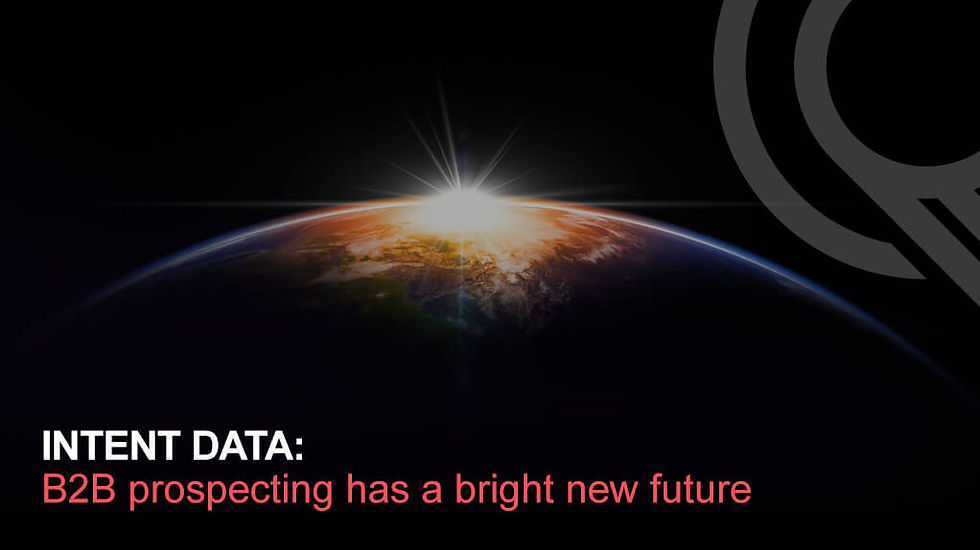Intent data: B2B prospecting has a bright new future
- Roger Wilks

- Jul 13, 2019
- 4 min read
Updated: Jul 11, 2024
"There be gold in them thar hills". An exclamation heard all too infrequently in the world of B2B marketing. Which of course is a shame. But while marketers are not (typically) mining for precious metals in 19th century California, they are mining for another precious commodity: customer insights. Where hills are formed from the data relating to a customer's online behaviour, and where gold comes in the form of little nuggets of intelligence that detail what they're doing – and the stage they've reached in the buyer journey.

Not that you need me to tell you that marketing today is increasingly driven by customer data. But this alone is no longer enough to deliver the engagement levels companies aspire to. Which is why intent data – that rich mix of behavioural insights into what prospects are thinking and doing – is becoming ever more popular.
SO WHAT DO WE MEAN BY INTENT DATA?
Well, the simple answer is that its information collected on a person or a company's engagement activities. Data from contact forms, online interactions, and your CRM platform etc., brought together to create more personalised and relevant customer interactions across each step of the buyer journey. Data that once gathered helps uncover customer intent toward your products and services – thereby helping boost lead generation efforts and overall marketing ROI.
As for generating intent data, this can be done by focusing on these key points of research:
Search: identifying the keywords and search terms your customers are using, which can then be used to narrow down the type of information you want to be sending back to them. To this should be added informational, navigational, and internal site search queries.
Browser: tracking a customer's cookies and browsing history to discover exactly what content is a cause of interest, while also detailing the specific language and research methods employed.
Action: by understanding what individual experiences cause users to buy or leave, you can get to work generating leads that are better qualified – before they even come to your website.
Firmographic: segmenting the organisations that interact with you, and matching a person's intent information with an individual account to develop a better understanding of what organisations are truly interested in.
Predictive – by aggregating the above sources of data, you can get busy analysing patterns and similarities that affect a customer's future trends, actions, and behaviours - data points that help uncover both present and future requirements.
Intent data can, therefore, deliver a wealth of behavioural intelligence for use in optimising buyer journeys. But it needs to be complete, and it needs to be verified. Parameters, such as time and incomplete data, should always be factored into the overall equation. Any lapses here (for example, it's estimated that as 70% of CRM data becomes obsolete within a year) have the potential to undermine all future ‘tailoring' efforts.
CHALLENGE AND OPPORTUNITY
As for the benefits on offer from intent data, these I'd suggest can be divided into three main categories:
Efficiency gains – and helping you discover and propose solutions that streamline your interactions with prospects and customers
Pipeline quality – and generating movement throughout the sales funnel by monitoring various activities and aligning right message/right time based on actual buyer intent
Increasing customer win-rates – and devising engagement techniques that have a far better ‘win rate' when it comes to turning active users into customers.
But when it comes to this time of data mining, not every strike is guaranteed to create instant riches. Challenges still need to be overcome in the search for customer gold, including:
Ensuring data quality
Managing and modelling data
Aligning sales and marketing
Getting your timing right
INTENTION IS DRIVING THE FUTURE OF B2B MARKETING
Intent data for marketers really is the purest form of market research available to them. Invest time in its collection and analysis and you'll soon reach a position of knowing what a prospect is interested in, what stage of the buyer journey they've reached, and what's likely to stimulate their ‘next best action' on the way to a purchase decision.
Not bad for an afternoon's work.
What's more, it's the basis for creating on-demand marketing to target specific profiles – and for invigorating even the blandest of ABM initiatives. Add ‘timeliness' to this personalisation advantage, and you increase engagement levels still further – as well as overall ROI figures.
And finally, there's the ‘closed-loop' nature of intent data. Here you use existing insights to create a baseline of ‘ready to buy' signals, uncover patterns and key triggers, before integrating this knowledge into future marketing campaigns to supercharge the buyer journey.
Hence why it really does represent a bold next step in the evolution of B2B marketing.
CONCLUSION
In a digital economy data remains the lifeblood of all marketing efforts and strategies. But traditional measurements designed to offer insights into customer behaviour, including demographics etc., are no longer enough to paint the three-dimensional customer picture required by sales and marketing alike. Instead, the emphasis is increasingly shifting toward the use of intent data – and the myriad buyer signals presented – to efficiently target the right customers at the right time, and to encourage B2B customers to buy. Get this right and you can gain a clear competitive advantage – and enjoy more meaningful engagement with audiences. Sound like a gold mine?




Comments